OR/14/043 Site description - Tarren Yr Esgob: Difference between revisions
m 1 revision imported |
|
(No difference)
| |
Latest revision as of 08:16, 5 April 2016
| Farr, G, Graham, J, and Stratford, C. 2014. Survey, characterisation and condition assessment of Palustriella dominated springs 'H7220 Petrifying springs with tufa formation (Cratoneurion)' in Wales. British Geological Survey Internal Report, OR/14/043. |
Introduction
Tarren yr Esgob is located on and accessed via privately owned land, north of Abergavenny near SO2392631499 and is part of the Black Mountains SSSI. The site comprises of a spring head/diffuse seepage area and resultant runnel that flows down a steep scree slope forming a small tributary to the Nant Bwch. There is a large area of tufa deposited along the runnel from the source down to the break in slope. The GPS could not pick up reception and detailed elevations were not obtained.
Geological and hydrogeological data
The high land surrounding Tarren yr Esgob comprises rocks from the Senni Formation of the Devonian Old Red Sandstone underlain by a silicate–conglomerate but importantly a calcite cemented unit, also known as a ‘calcrete’. This calcrete forms part of the upper catchment of Tarren yr Esgob and is underlain by the St Maughns Formation. It is the calcrete that is the most likely source of CaCO3. Mole hills on the slope adjacent to the site produced a typical red-brown looking soil often associated with the Old Red Sandstone, however the soil was rich with calcareous fragments, possibly reworked tufa deposits.
Groundwater in the Devonian rocks will primarily flow along bedding planes, between fractures and fissures (secondary permeability) but also within the rock matrix (primary permeability). During this process, and whilst in contact with the calcrete, the groundwater has an opportunity to become supersaturated with CaCO3 providing the ideal chemical conditions for tufa deposition. At the top of the site, close to the main cliff, water can be seen seeping along bedding planes and fractures within the bedrock and some of the vertical rock faces are forming tufa deposits.
Three water quality samples were collected that represent the upper (TyE1.1 seepage direct from bedrock at SO2392631499), middle (TyE1.3 at 30–40 meters from the top SO239323149) and lower part of the site (TyE1.6 at SO2399731591). The previous night (17/01/2014) had seen heavy rainfall in this part of Wales and the flow and level within the runnel was elevated. Field readings of the water quality show that pH was 8.16 at the top of the site and gradually changed towards the base of the site where it was recorded at pH8.3. The electrical conductivity of the water also fell from 244 μs/cm at the top of the site to 204 μs/cm at the base. Nutrient levels are low with readings close to or below limits of detection for phosphate/orthophosphate and nitrate.
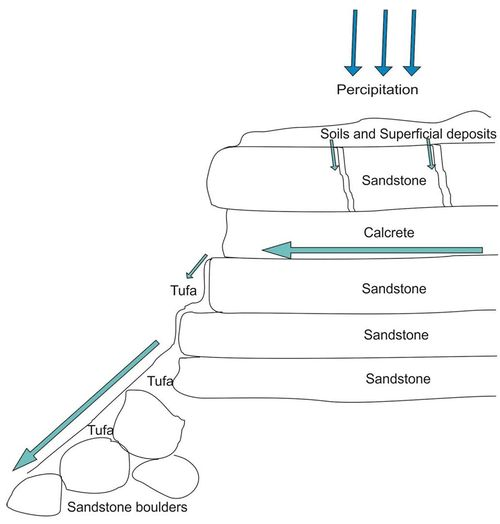
Land use and pressures
Tarren yr Esgob is located on privately owned land and access to the site is away from the main footpaths, so footfall is expected to be limited. The area is horse and sheep grazed and there are no obvious signs of poaching. There is no evidence of burning or obvious signs of nutrient enrichment at any part of the site. It is unlikely that there are any groundwater or surface water abstractions in the immediate area.
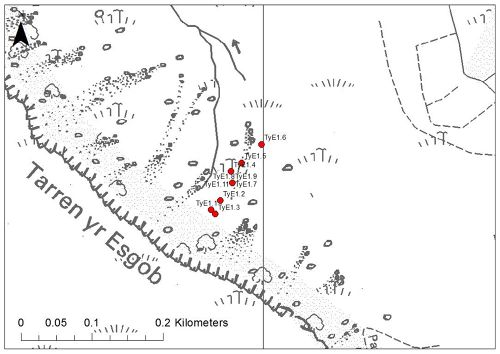
© Ordnance Survey.
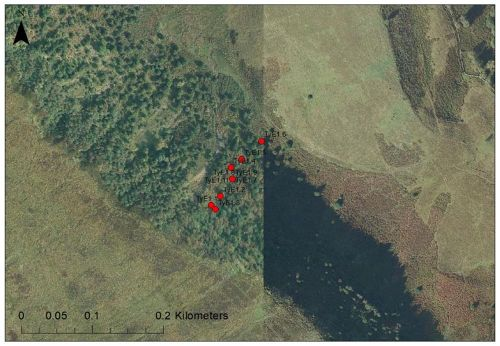
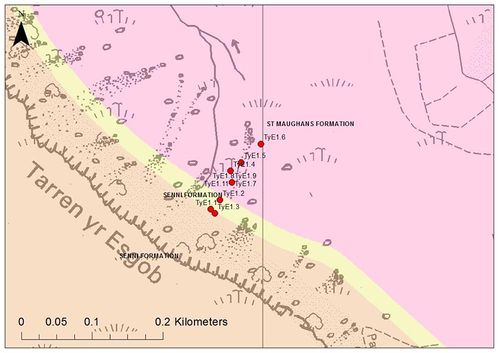

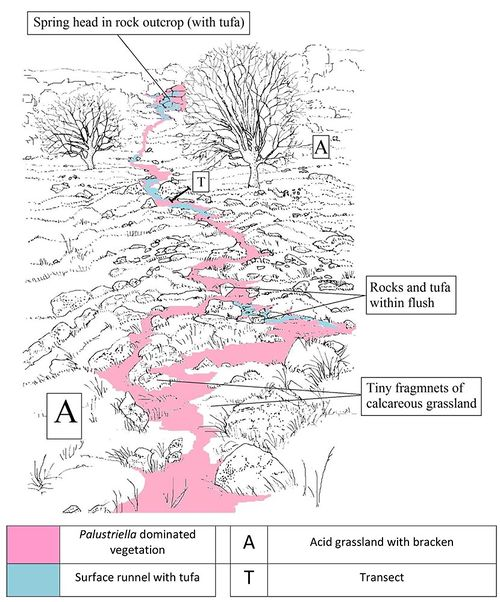
Vegetation (spring) for Tarren-yr-Esgob
An upland edge rocky spring with marginal Palustriella commutata dominated vegetation and frequent tufa dominated by Hymenostylium recurvirostrum, Jungermannis atrovirens, Preissia quadrata, the algae Rivularia haematites and occasional cushions of Gymnostomum aeruginosum. The spring head appears at the base of a rocky ledge with extensive and well developed dripping matts of Palustriella commutata with Festuca rubra. Along the margins of the main steep central runnel Palustriella commutata dominated vegetation supports a number of other bryophytes including Fissidens adianthoides, Philonotis calcarea, Ctenidium molluscum, Bryum psedutriquetrum, occasional Riccardia multifida, Jungermannas exertifolia ssp. cordifolia but lacks the Scorpidium species and Campylium stellatum characteristic of similar looking upland flushes sampled. Parts of the site are shaded both by large bolders and small trees (Salix & Crataegus monogyna) and Deschapsia cespitosa is locally frequent along the margins of runnels.
| Agrostis stolonifera | R (<1%) |
| Aneura pinguis | F |
| Bryum pseudotriquetrum (spor.) | R |
| Calliergonella cuspidata | R |
| Cardamine pratensis | R |
| Carex flacca | F |
| Cirsium palustre | R |
| Ctenidium molluscum | R |
| Deschampsia cespitosa | O |
| Festuca ovina | R (<1%) |
| Festuca rubra | R |
| filamentous algae (Chlorophyta) | O |
| Fissidens adianthoides | O |
| Gymnostomum aeruginosum | R |
| Hymenostylium recurvirostrum | F |
| Juncus acutiflorus | F |
| Jungermannia atrovirens (per.) | A |
| Jungermannia exsertifolia ssp. cordifolia (non fertile) | R |
| Nostoc sp. | O |
| Palustriella commutata | A |
| Pellia endiviifolia | R |
| Philonotis calcarea | R |
| Plantago lanceolata | R |
| Pressia quadrata | R |
| Primula sp. | R |
| Prunella vulgaris | R |
| Ranunculus repens | R (<1%) |
| Riccardia multifida | R |
| Rivularia haematites | F |
| Trifolium repens | R (<1%) |
Rocks (including large boulders) within the area of flush/spring but above level of seepage water supporting occasional mixtures of calcareous as well as calcifuges bryophytes, lichens and ferns.
| Asplenium adiantum-nigrum | R |
| Asplenium viride | R |
| Bryum capillare | R |
| Cladonia pyxidata | R |
| Frullania tamarisci | R |
| Grimmia trichophylla | R |
| Hypnum cupressiforme | O |
| Pressia quadrata | O |
| Racomitrium fasiculare | O |
| Racomitrium lanuginosum | R |
| Tortella tortuosa | F |
Vegetation (adjoining spring) for Tarren-yr-Esgob
Tiny fragments of upland calcareous grassland on drier rocky areas ajoining the central channel. These small areas of grassland are dominated by Cynosurus, Festuca ovina and lightly horse grazed. Locally, species rich patches occur with Linum catharticum, Pilosella and Thymus.
| Agrostis stolonifera | R |
| Bellis perennis | R |
| Ctenidium molluscum | A |
| Cynosurus cristatus | F |
| Festuca ovina | O |
| Linum catharticum | R |
| Pilosella officinarium | R |
| Polygala serpyllifolia | R (<1%) |
| Prunella vulgaris | R |
| Rhytidiadelphus triquetrus | O |
| Thymus polytrichus | O |
| Viola cf hirsuta | R |
Acid grassland (Molinia, Dicranum scoparium, Hylocomium splendens) with scattererd Pteridium. On steeper rocky slopes where grazing is limited, occasional stands of Vaccinium myrtillus and Empetrum nigrum occur.
| Betula pubescens (seedling) | R |
| Dicranum scoparium | O |
| Empetrum nigrum | R (<1%) |
| Galium saxatile | R |
| Hylocomium splendens | O |
| Mnium hornum | R |
| Molinia caerulea | O |
| Pleurozium schreberi | O |
| Polytrichum formosum | R |
| Potentilla erecta | R |
| Pteridium aquilinum | F |
| Rhytidiadelphus loreus | O |
| Salix sp. (seedling) | R (<1%) |
| Scleropdium purum | R |
| Thuidium tamariscinum | R |
| Vaccinium myrtillus | R |
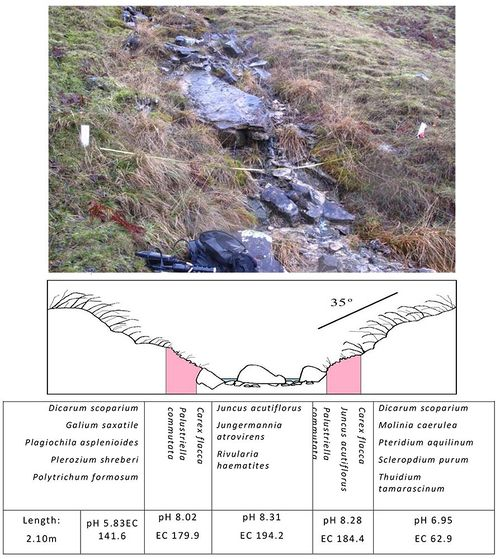
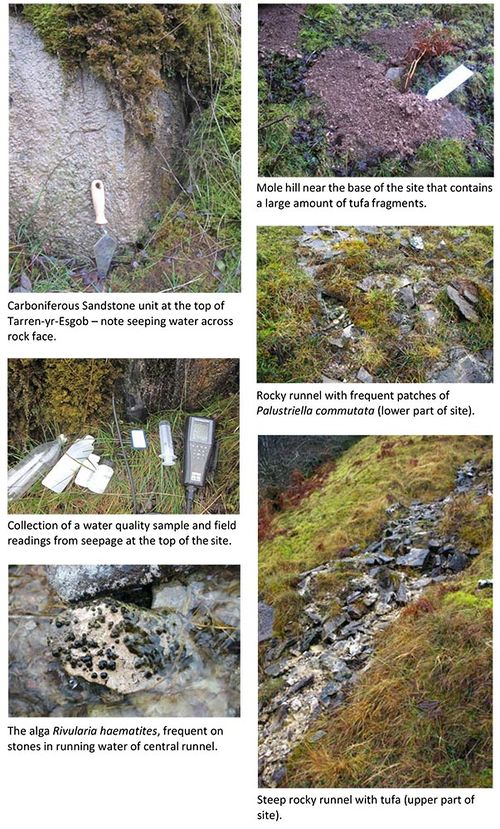
Condition assessment
The overall assessment is that Tarren-yr-Esgob should be classified as being in favourable ecological and hydrogeological condition.